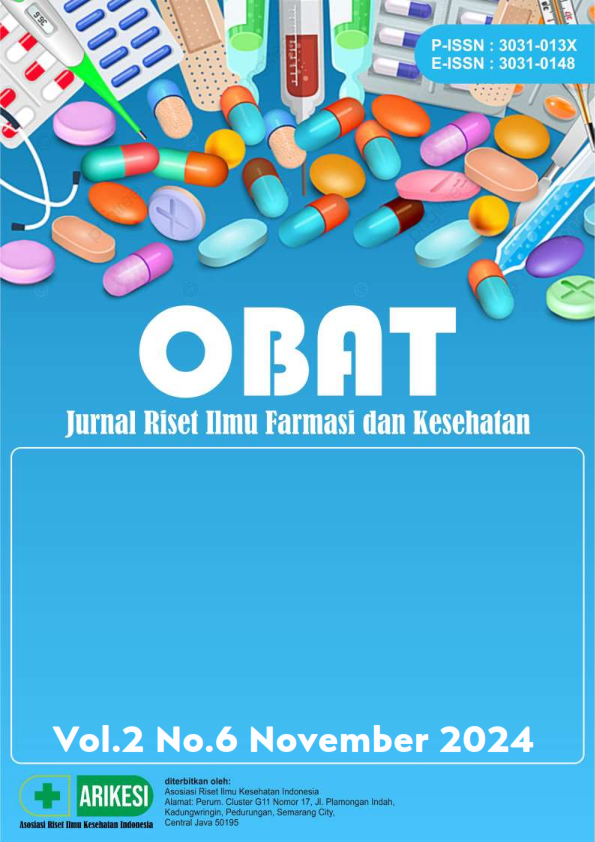Manajemen Rhinitis Alergi
DOI:
https://doi.org/10.61132/obat.v2i6.800Keywords:
Allergic rhinitis, Risk factors, Immunoglobulin EAbstract
Allergic rhinitis (AR) is an atopic disease characterized by symptoms of nasal congestion, clear rhinorrhea, sneezing, postnasal drop, and nasal pruritis. The disease affects one in six people and is associated with significant morbidity, loss of productivity, and health care costs. Historically, AR was considered a disease process in the nasal airways only, although it is not serious, allergic rhinitis should be considered as a quite serious condition because it can affect the sufferer's quality of life due to the severity of the symptoms experienced and can also cause various complications. However, the development of integrated airway theory has classified AR as a component of the systemic allergic response, with other related conditions, such as asthma and atopic dermatitis, having an underlying systemic pathology. Even though it is not serious, allergic rhinitis should be considered as a quite serious condition because it can affect the sufferer's quality of life due to the severity of the symptoms experienced and can also cause various complications. In addition to nasal symptoms, patients with AR may also experience allergic conjunctivitis, non-productive cough, Eustachian tube dysfunction, and chronic sinusitis. Once diagnosed, AR can be treated in a variety of ways, with intranasal glucocorticoids being the first line of therapy.
Downloads
References
Al-Abri, R., Al-Amri, A. S., Al-Dhahli, Z., & Varghese, A. M. (2018). Allergic rhinitis in relation to food allergies: Pointers to future research. Sultan Qaboos University Medical Journal, 18(1), e30-e33. https://doi.org/10.18295/squmj.2018.18.01.005
Chong, S. N., & Chew, F. T. (2018). Epidemiology of allergic rhinitis and associated risk factors in Asia. World Allergy Organization Journal, 11(1). https://doi.org/10.1186/s40413-018-0198
Głobińska, A., Boonpiyathad, T., Satitsuksanoa, P., Kleuskens, M., van de Veen, W., Sokolowska, M., & Akdis, M. (2018). Mechanisms of allergen-specific immunotherapy: Diverse mechanisms of immune tolerance to allergens. Annals of Allergy, Asthma & Immunology, 121(3), 306-312.
Hapsari, T. D. K. R., Wulandari, M., & Haryadi Sabilla, S. R. (2020). Hubungan antara rhinitis alergi dengan sinusitis pada pemeriksaan foto sinus paranasal. Jurnal Ilmiah Kesehatan Sandi Husada, 9(2), 966-970.
Hossenbaccus, L., Linton, S., Garvey, S., & Ellis, A. K. (2020). Towards definitive management of allergic rhinitis: Best use of new and established therapies. Allergy, Asthma & Clinical Immunology, 16(39). https://doi.org/10.1186/s13223-020-00436-y
Jean, T. (2022). Allergic rhinitis. Medscape. https://emedicine.medscape.com/article/134825-overview
Katotomichelakis, M., Iliou, T., Karvelis, I., Giotakis, E., Danielides, G., Erkotidou, E., et al. (2017). Symptomatology patterns in children with allergic rhinitis. Medical Science Monitor, 23, 4939-4946. https://doi.org/10.12659/MSM.903136
Kim, D. W., Kim, D. K., Eun, K. M., Bae, J. S., Chung, Y. J., & Xu, J., et al. (2017). IL-25 could be involved in the development of allergic rhinitis sensitized to house dust mite. Mediators of Inflammation.
Lipworth, B., Newton, J., Ram, B., Small, I., & Schwarze, J. (2017). An algorithm recommendation for the pharmacological management of allergic rhinitis in the UK: A consensus statement from an expert panel. NPJ Primary Care Respiratory Medicine, 27(1), 3.
Madiadipoera, T., & Utami, R. (2021). Strategi penatalaksanaan rinitis alergi untuk mengoptimalkan kualitas hidup pasien. Medicinus, 34, 3-10.
Munstedt, K., & Mannle, H. (2020). Seasonal allergic rhinitis and the role of apitherapy. Allergologia et Immunopathologia, 48(6), 582-588.
Neuropsychiatric events following montelukast use: A propensity score matched analysis. (2021). Sentinel Initiative. https://www.sentinelinitiative.org/drugs/assessments/neuropsychiatric-events-following-montelukast-use-propensity-score-matched
Nuhurtami, A. D., Suprihati, & Marliyawati, D., Dewi, A. M. K. (2020). Faktor risiko rhinitis alergi pada anak usia 13-14 tahun di Semarang. Diponegoro Medical Journal, 9(2).
Pengurus Besar Ikatan Dokter Indonesia. (2017). Panduan praktik klinis bagi dokter di fasilitas pelayanan kesehatan tingkat pertama. Jakarta: Pengurus Besar Ikatan Dokter Indonesia.
Ridolo, E., Martignago, I., & Masieri, S. (2018). Mechanisms of allergic diseases in otorhinolaryngology. Journal of Biological Regulators and Homeostatic Agents, 32(1 Suppl. 1), 9-12.
Settipane, R. A., Sharma, H. P., Sheikh, A., Smith, T. L., Tantilipikorn, P., Tversky, J. R., et al. (2018). International consensus statement on allergy and rhinology: Allergic rhinitis. International Forum of Allergy & Rhinology, 8(2), 108-352.
Strzelak, A. (2018). Tobacco smoke induces and alters immune responses in the lung triggering inflammation, allergy, asthma and other lung diseases: A mechanistic review. International Journal of Environmental Research and Public Health. https://doi.org/10.3390/ijerph15051033
Vandenplas, O., Vinnikov, D., Blanc, P. D., Agache, I., Bachert, C., Bewick, M., et al. (2018). Impact of rhinitis on work productivity: A systematic review. The Journal of Allergy and Clinical Immunology: In Practice, 6(4), 1274-1286.e9.
Downloads
Published
How to Cite
Issue
Section
License
Copyright (c) 2024 OBAT: Jurnal Riset Ilmu Farmasi dan Kesehatan

This work is licensed under a Creative Commons Attribution-ShareAlike 4.0 International License.





